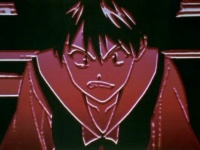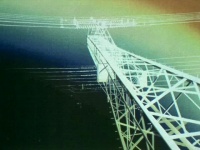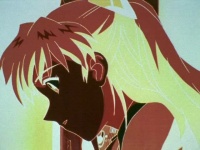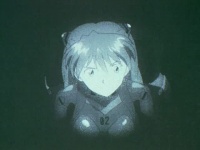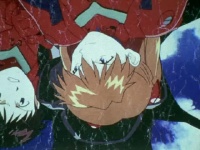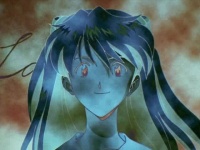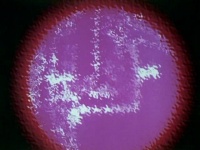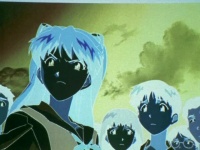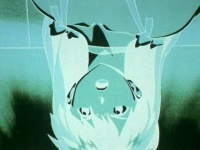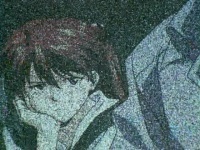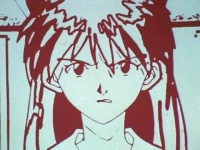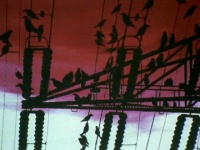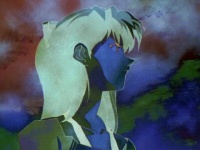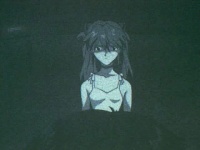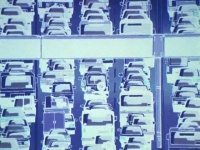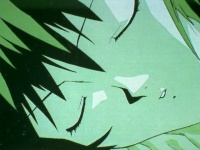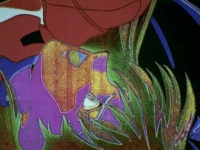What is this?
This is not actually user page, for all the blissful wanderers out there. It is a "pitch" page for an critical essay on Neon Genesis Evangelion and its use of montage. Currently, I am in the beginning stages of writing the essay, and I will be posting bits and pieces of the essay as I go along, in hopes of getting feedback from the Wiki Users.
Current Status
As of Feb. 24, 2010:
Posting the intial outline/preface/proposal
As of Feb. 25, 2010:
Going into a bit more detail in the montage introduction, images added.
As of Feb. 26, 2010:
1st montage interpretation
The Essay
Evangelion is usually looked at in a narrative sense, but it is necessary to also assess it at the technical level of cinematography, and specifically in this essay, at the level of montage. There are several montage sequences in the series, but they are most notable and pronounced in Episodes 14, 22, and 26'. Though there are others, the montage sequences in these three episodes will be broken down in the first edition of this critical essay.
Introduction to the Classical Theory of Montage:
The montage theory was developed by Soviet filmmaker/theorist Sergei Eisenstein in 1922 with his seminal cinematic treatise A Dialectic Approach to Film Form. This treatise, in summary, presented the theory in these terms:
- 1.The images in the montage are not there for the explicit reason of existing as separate identities. The key aspect of the montage sequence is that the images are all linked to one another. Each image's meaning builds and is built upon by the previous and consecutive images.
- 2.According to Eisenstein, the montage theory solved the “specific problem of cinema”- medium specificity.
- 3.The montage is, in essence, is “a conflict between images” in which the incomplete subtext from the previous two images “collide” together, and present a newer, complete meaning at the end of the montage.
An application of this theory in Evangelion would be this sequence of shots:
| Montage Sequence
|
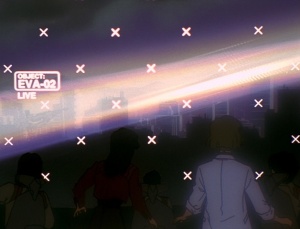 |
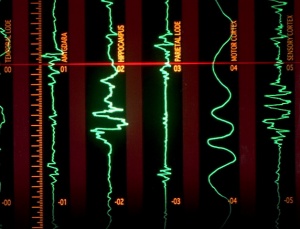 |
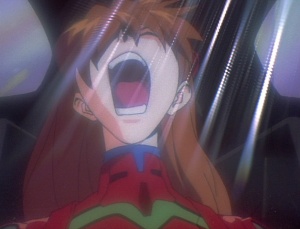
|
|
Episode #22 Cuts
- A) In this shot, we see a beam of light shine down on Tokyo-3, aimed at Evangelion Unit 3. The NERV members watch it anxiously. But what exactly is going on? What type of angel attack is this? As it can bee seen, this image is incomplete on its own, and, without its succeeding images, would be a shot that would have little meaning.
- B) Now,we have an image that depicts one of the computer terminals reading statistics on what appears to be Asuka's brain waves. As it can be seen, the waves have risen sharply. Something is going on, it is just unclear as to what exactly it is. This shot has built upon the greater meaning of the first, and this is a step in understanding the montage. But what follows next will actually reveal the nature of the montage.
- C) And there is the meaning! Asuka has been attacked by the angel-- that is to say, that our worst fears have been realized. The light, the rainbow, and then Asuka herself were all shots that, when built upon each other, are able to give the viewer context and meaning. Though this seems like a very basic and obvious deconstruction of those three images, when it comes to actually assessing the visual discord in the rapid paced montages in Asuka's mindrape later during the episode, this kind of basic knowledge must be there-- otherwise we will possibly look at the montage images in seperate entities. This cannot be risked due to losing a greater meta-meaning in the montage sequence itself.
|
How versed is Anno in in these techniques?
With these fundamental aspects in mind, let it be known that it is currently unclear whether or not Anno had ever come across any of Eisenstein's theoretical papers. Any good student of film or animation should at some point, because his theories were extremely important to the development of modern cinema, but it should be realized that the status of Anno as a good films student is a matter of question – considering that he admitted to being familiar with Jean Luc Godard, another important montage theorist, but became familiar with several Japanese filmmakers who used Godard's techniques in a similar fashion.
The montage, and the theory behind it, however, has been more or less assimilated into the universal film-making language, however. To say that these montage theory is irrelevant due to the fact that it is still in question about Anno's familiarity with the subject, it is most likely the case that he was knowledgeable about it just by being able to make one.
Episode 22
The montage sequences that are most notable are the ones presented in the "mind-rape" scenes, in which Asuka has her deepest, darkest memories brought to the surface, further compounding her insecurities. As her forced introspection reaches the point of climax, the viewer is presented with a total deconstruction of Asuka in every sense of the word. We see her thoughts, desires, and feelings laid before us, and there reaches a point in which we see the beginning of Asuka's downward spiral, her rejection of The Other, most notably manifest in three beings: Her mother, Kaji, and Shinji.
Here is the final of these mind-rape montages:
| Montage Sequence
|
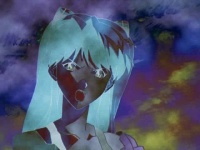 |
 |
 |
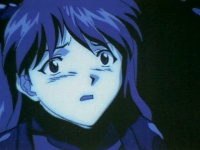
|
 |
 |
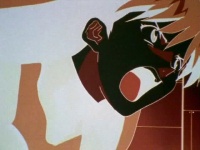 |
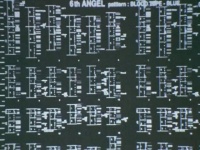
|
 |
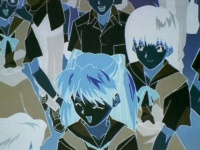 |
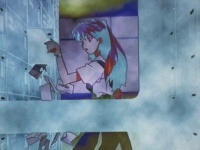 |
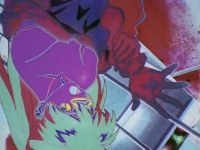
|
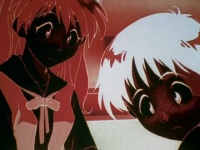 |
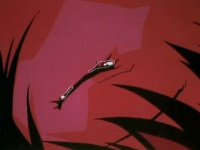 |
 |
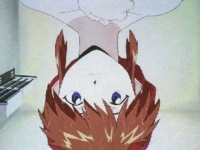
|
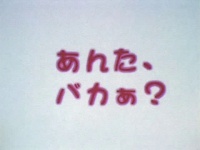 |
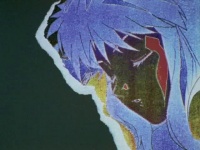 |
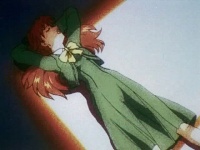 |
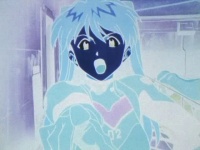
|
 |
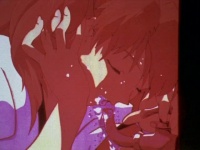 |
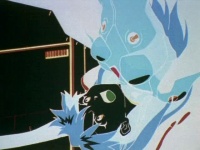 |
|
|
Episode #22 Cuts
- What we see are twenty-three different images, shots of Asuka in various emotional states, even information on the 6th angel, and what seems to be like a cracking facade. These, though they may seem like disconnected images, are actually all images that follow particular themes that pay off in a particularly interesting way in relation to the forced introspection on the part of Asuka
- Shots 1-4: What we see are two images of Asuka-- one condescending, and one of a determined/angry look on Asuka's face. But there is most notably a "tear" in the shot, which indicates either a tear, or crack in Asuka's personality. This is to say that this is not the complete and true person of Asuka, as we have seen now. But, the two images are also speaking in a narrrative sense. At the outset of the narrative, Asuka was both of these, but we know that this was just a facade put on by her, hence the shot of Tokyo-3's facade. A face of a mortified Asuka is the first of several sub-payoffs, shots that reinforce statements made by the previous shots, and act as transitions in this case. Asuka realizes that these two things are not hwe true self -- but her is questioning, as well, what is her true nature? And what defines it?
- Shots 5-16: We see another determined look on the part of Asuka, but what is she determined about? The next shot confirms what: Shinji. She is wearing the same bathing suit that she wore in Episode 10. But is this just some good-humored flirtation on Asuka's part? Asuka again looks determined, a shot that also suggests that she is revving up her Eva. The next shot confirms it: Angel number six. Asuka's first time in combat. And what happens? She allows Shinji, to enter the heart (or womb, if one takes the Freudian approach), you might say, if one were to think of it in such a manner. Asuka is inviting Shinji into something sacred: what she truly only sees as an identifying body: her Eva, and her status as an Eva pilot. We see, in essence, an acceptance of Shinji as a potential significant other. Note the Eva=Mother/Shinji=Significant Other dichotomy.
- Next we have Asuka in a school uniform. This is the first time she is in one, and she does not look thrilled. But we see a totally different expression on Asuka's face in the next shot. Why? This is another well placed reinforcement about Asuka's own projected images of herself as the "popular foreign girl". Her displeasure at the love letters in her gym locker confirms this. She is not attempting to impress these other boys -- she is trying to impress the person (people, possibly including Kaji) who she has been "going after" -- Shinji.
- Next we see shots furthering the Asuka/Shinji theme of this montage. Asuka angry over Shinji's pervertedness -- but notice the placement of the shot. It is upside down -- my theory behinf this is that turning the shot upside down is a method of refuting the content and subtext within the shot. That is to say that Asuka seems embarressment over the implication of Shinji's pervertedness, but in an equally perverted way, she wants his gaze. The relationship implication "the newlyweds", Toji said, embarrasses both Shinji and Asuka. Judging by the usual anime-implications of the notable "full-face" blush, both of them want the relationship to occur -- it is just that Asuka is exploring, albeit awkwardly, the feasability of the relationship, and that Shinji is perhaps blushing over Toji's perceptiveness, along with his own inability to reach out to Asuka.
- Next, we have a shot of real vulnerability. Asuka's sobbing over her mother as she sleeps in Shinji's bed. Again we are returning to an exploration of the mother vs. significant other theme. The next shot is more overt flirtatiousness on the part of Asuka. Again, this is more attention getting behavior on her part, sexualizing herself for the male gaze.
- Finally, the key statement made in this sub-montage: She, throughout the series, actively rejected her statement of hatred of Shinji in Episode 22. She is reacting adversely to the inability of Shinji to properly respond, but she still wants him.
- Shots 17-23: The conclusion of sorts. We see an intertitle that reads "Are you stupid?". This quote, almost always directed at Shinji, rings especially true. "Are you stupid," she asks, "because you refuse to respond to me?!". With her going as far as climbing into his bed, shown in the next shot, and canceling a date with another boy, shown in the shot after that, she is justifiably angry. The next shot builds on the "are you stupid theme", an almost fully accusative shot, pointing a finger at Shinji.
- In the final three shots, we will finally reach the conclusion, the climax, the major statement that this montage has been building up to. We see a misty scene, so what we can imply is that there is a truth needing to be unveiled, a secret code needing to be cracked: What does Asuka want? In what seems to be a phallic allegory, the answer is simply: Shinji. And with the final shot of her piloting flipped, one can only assume that this realization has turned all of her facades, defense mechanisms, and her justifcation for existence completely upside-down.
|
